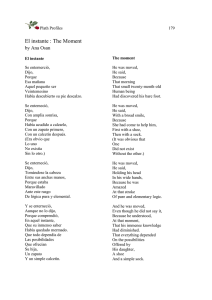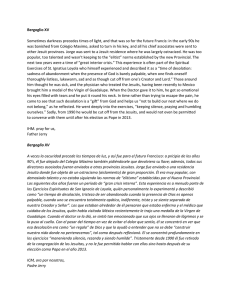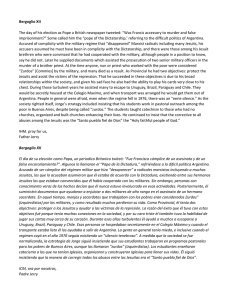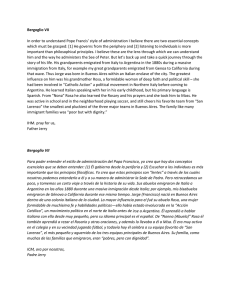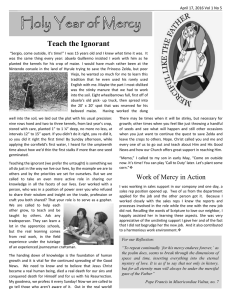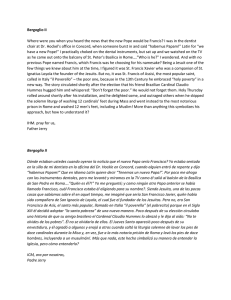Museo Nacional Centro de Arte Reina Sofía
Anuncio
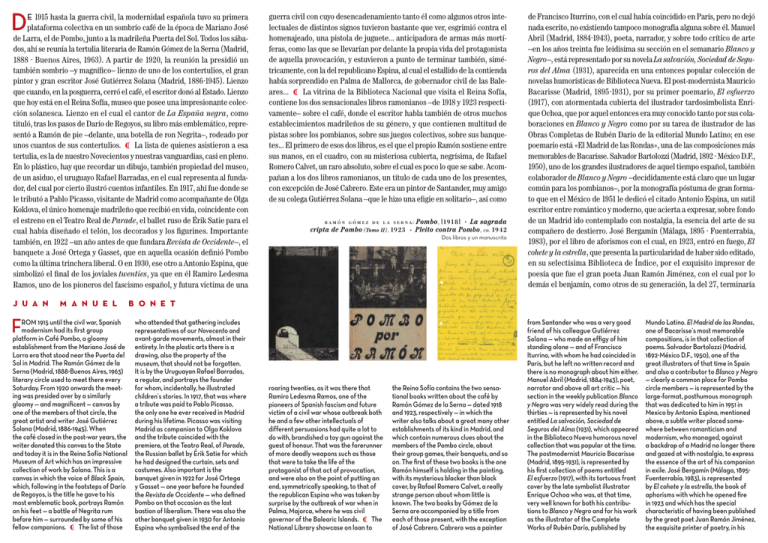
D E 1915 hasta la guerra civil, la modernidad española tuvo su primera plataforma colectiva en un sombrío café de la época de Mariano José de Larra, el de Pombo, junto a la madrileña Puerta del Sol. Todos los sábados, ahí se reunía la tertulia literaria de Ramón Gómez de la Serna (Madrid, 1888 - Buenos Aires, 1963). A partir de 1920, la reunión la presidió un también sombrío –y magnífico– lienzo de uno de los contertulios, el gran pintor y gran escritor José Gutiérrez Solana (Madrid, 1886 -1945). Lienzo que cuando, en la posguerra, cerró el café, el escritor donó al Estado. Lienzo que hoy está en el Reina Sofía, museo que posee una impresionante colección solanesca. Lienzo en el cual el cantor de La España negra, como tituló, tras los pasos de Darío de Regoyos, su libro más emblemático, representó a Ramón de pie –delante, una botella de ron Negrita–, rodeado por unos cuantos de sus contertulios. ¶ La lista de quienes asistieron a esa tertulia, es la de nuestro Novecientos y nuestras vanguardias, casi en pleno. En lo plástico, hay que recordar un dibujo, también propiedad del museo, de un asiduo, el uruguayo Rafael Barradas, en el cual representa al fundador, del cual por cierto ilustró cuentos infantiles. En 1917, ahí fue donde se le tributó a Pablo Picasso, visitante de Madrid como acompañante de Olga Koklova, el único homenaje madrileño que recibió en vida, coincidente con el estreno en el Teatro Real de Parade, el ballet ruso de Érik Satie para el cual había diseñado el telón, los decorados y los figurines. Importante también, en 1922 –un año antes de que fundara Revista de Occidente–, el banquete a José Ortega y Gasset, que en aquella ocasión definió Pombo como la última trinchera liberal. O en 1930, ese otro a Antonio Espina, que simbolizó el final de los joviales twenties, ya que en él Ramiro Ledesma Ramos, uno de los pioneros del fascismo español, y futura víctima de una j uan F manuel ROM 1915 until the civil war, Spanish modernism had its first group platform in Café Pombo, a gloomy establishment from the Mariano José de Larra era that stood near the Puerta del Sol in Madrid. The Ramón Gómez de la Serna (Madrid, 1888-Buenos Aires, 1963) literary circle used to meet there every Saturday. From 1920 onwards the meeting was presided over by a similarly gloomy — and magnificent — canvas by one of the members of that circle, the great artist and writer José Gutiérrez Solana (Madrid, 1886-1945). When the café closed in the post-war years, the writer donated this canvas to the State and today it is in the Reina Sofía National Museum of Art which has an impressive collection of work by Solana. This is a canvas in which the voice of Black Spain, which, following in the footsteps of Darío de Regoyos, is the title he gave to his most emblematic book, portrays Ramón on his feet — a bottle of Negrita rum before him — surrounded by some of his fellow companions. ¶ The list of those guerra civil con cuyo desencadenamiento tanto él como algunos otros intelectuales de distintos signos tuvieron bastante que ver, esgrimió contra el homenajeado, una pistola de juguete... anticipadora de armas más mortíferas, como las que se llevarían por delante la propia vida del protagonista de aquella provocación, y estuvieron a punto de terminar también, simétricamente, con la del republicano Espina, al cual el estallido de la contienda había sorprendido en Palma de Mallorca, de gobernador civil de las Baleares... ¶ La vitrina de la Biblioteca Nacional que visita el Reina Sofía, contiene los dos sensacionales libros ramonianos –de 1918 y 1923 respectivamente– sobre el café, donde el escritor habla también de otros muchos establecimientos madrileños de su género, y que contienen multitud de pistas sobre los pombianos, sobre sus juegos colectivos, sobre sus banquetes... El primero de esos dos libros, es el que el propio Ramón sostiene entre sus manos, en el cuadro, con su misteriosa cubierta, negrísima, de Rafael Romero Calvet, un raro absoluto, sobre el cual es poco lo que se sabe. Acompañan a los dos libros ramonianos, un título de cada uno de los presentes, con excepción de José Cabrero. Este era un pintor de Santander, muy amigo de su colega Gutiérrez Solana –que le hizo una efigie en solitario–, así como r a m ó n g ó m e z d e l a s e r n a: Pombo, [ 1918 ] · La sagrada cripta de Pombo (Tomo II), 19 23 · Pleito contra Pombo, ca. 19 4 2 Dos libros y un manuscrito de Francisco Iturrino, con el cual había coincidido en París, pero no dejó nada escrito, no existiendo tampoco monografía alguna sobre él. Manuel Abril (Madrid, 1884-1943), poeta, narrador, y sobre todo crítico de arte –en los años treinta fue leidísima su sección en el semanario Blanco y Negro–, está representado por su novela La salvación, Sociedad de Seguros del Alma (1931), aparecida en una entonces popular colección de novelas humorísticas de Biblioteca Nueva. El post-modernista Mauricio Bacarisse (Madrid, 1895 -1931), por su primer poemario, El esfuerzo (1917), con atormentada cubierta del ilustrador tardosimbolista Enrique Ochoa, que por aquel entonces era muy conocido tanto por sus colaboraciones en Blanco y Negro como por su tarea de ilustrador de las Obras Completas de Rubén Darío de la editorial Mundo Latino; en ese poemario está «El Madrid de las Rondas», una de las composiciones más memorables de Bacarisse. Salvador Bartolozzi (Madrid, 1892 - México D.F., 1950), uno de los grandes ilustradores de aquel tiempo español, también colaborador de Blanco y Negro –decididamente está claro que un lugar común para los pombianos–, por la monografía póstuma de gran formato que en el México de 1951 le dedicó el citado Antonio Espina, un sutil escritor entre romántico y moderno, que acierta a expresar, sobre fondo de un Madrid ido contemplado con nostalgia, la esencia del arte de su compañero de destierro. José Bergamín (Málaga, 1895 - Fuenterrabía, 1983), por el libro de aforismos con el cual, en 1923, entró en fuego, El cohete y la estrella, que presenta la particularidad de haber sido editado, en su selectísima Biblioteca de Índice, por el exquisito impresor de poesía que fue el gran poeta Juan Ramón Jiménez, con el cual por lo demás el benjamín, como otros de su generación, la del 27, terminaría b o n e t who attended that gathering includes representatives of our Novecento and avant-garde movements, almost in their entirety. In the plastic arts there is a drawing, also the property of the museum, that should not be forgotten. It is by the Uruguayan Rafael Barradas, a regular, and portrays the founder for whom, incidentally, he illustrated children’s stories. In 1917, that was where a tribute was paid to Pablo Picasso, the only one he ever received in Madrid during his lifetime. Picasso was visiting Madrid as companion to Olga Koklova and the tribute coincided with the premiere, at the Teatro Real, of Parade, the Russian ballet by Érik Satie for which he had designed the curtain, sets and costumes. Also important is the banquet given in 1922 for José Ortega y Gasset — one year before he founded the Revista de Occidente — who defined Pombo on that occasion as the last bastion of liberalism. There was also the other banquet given in 1930 for Antonio Espina who symbolised the end of the roaring twenties, as it was there that Ramiro Ledesma Ramos, one of the pioneers of Spanish fascism and future victim of a civil war whose outbreak both he and a few other intellectuals of different persuasions had quite a lot to do with, brandished a toy gun against the guest of honour. That was the forerunner of more deadly weapons such as those that were to take the life of the protagonist of that act of provocation, and were also on the point of putting an end, symmetrically speaking, to that of the republican Espina who was taken by surprise by the outbreak of war when in Palma, Majorca, where he was civil governor of the Balearic Islands. ¶ The National Library showcase on loan to the Reina Sofía contains the two sensational books written about the café by Ramón Gómez de la Serna — dated 1918 and 1923, respectively — in which the writer also talks about a great many other establishments of its kind in Madrid, and which contain numerous clues about the members of the Pombo circle, about their group games, their banquets, and so on. The first of these two books is the one Ramón himself is holding in the painting, with its mysterious blacker than black cover, by Rafael Romero Calvet, a really strange person about whom little is known. The two books by Gómez de la Serna are accompanied by a title from each of those present, with the exception of José Cabrero. Cabrero was a painter from Santander who was a very good friend of his colleague Gutiérrez Solana — who made an effigy of him standing alone — and of Francisco Iturrino, with whom he had coincided in Paris, but he left no written record and there is no monograph about him either. Manuel Abril (Madrid, 1884-1943), poet, narrator and above all art critic — his section in the weekly publication Blanco y Negro was very widely read during the thirties — is represented by his novel entitled La salvación, Sociedad de Seguros del Alma (1931), which appeared in the Biblioteca Nueva humorous novel collection that was popular at the time. The postmodernist Mauricio Bacarisse (Madrid, 1895-1931), is represented by his first collection of poems entitled El esfuerzo (1917), with its tortuous front cover by the late symbolist illustrator Enrique Ochoa who was, at that time, very well known for both his contributions to Blanco y Negro and for his work as the illustrator of the Complete Works of Rubén Darío, published by Mundo Latino. El Madrid de las Rondas, one of Bacarisse’s most memorable compositions, is in that collection of poems. Salvador Bartolozzi (Madrid, 1892-México D.F., 1950), one of the great illustrators of that time in Spain and also a contributor to Blanco y Negro — clearly a common place for Pombo circle members — is represented by the large-format, posthumous monograph that was dedicated to him in 1951 in Mexico by Antonio Espina, mentioned above, a subtle writer placed somewhere between romanticism and modernism, who managed, against a backdrop of a Madrid no longer there and gazed at with nostalgia, to express the essence of the art of his companion in exile. José Bergamín (Málaga, 1895Fuenterrabía, 1983), is represented by El cohete y la estrella, the book of aphorisms with which he opened fire in 1923 and which has the special characteristic of having been published by the great poet Juan Ramón Jiménez, the exquisite printer of poetry, in his n i p o : 032-12- 0 0 4 - 8 . d. l . : m -1 9 1 57-2 012 tarifando. Tomás Borrás (Madrid, 1891-1976) –cercanísimo a Gómez de la Serna ya desde los tiempos de la revista Prometeo, y que tuvo un destino distinto del de la mayoría de sus compañeros, ya que ya antes de la guerra se haría falangista–, por Fantochines (1923), con música de Conrado del Campo y preciosas ilustraciones y cubierta de Luis Bagaría, el más importante caricaturista de su tiempo español, uno de los «íntegros» ramonianos, y otro futuro exiliado, en este caso en La Habana. Por último, el prosista modernista venezolano –entonces residente aquí– Pedro-Emilio Coll (Caracas, 1872 -1947), el único extranjero y el más mayor de los retratados, por La escondida senda (Pláticas) (1927). Es curioso que Gutiérrez Solana sólo incluyera, aparte de a Ramón, y a sí mismo, a personajes cuyos apellidos empiezan por las tres primeras letras del alfabeto. Como si esto fueran los pombianos, por orden alfabético, y... hasta donde cabían en el lienzo, que idealmente podría haber sido decenas de lienzos más. 23 D E MAYO - 8 D E J U LI O D E 2012 23 D E MAYO - 8 D E J U LI O D E 2012 exposición · exhibition o r ga n i z a n · o r ga n i s e d by: Biblioteca Nacional de España y Acción Cultural Española (AC/E) comi sari o · cu rato r: Juan Manuel Bonet josé gutiérrez solana La tertulia del Café de Pombo, 19 20 Óleo sobre lienzo highly select Biblioteca de Índice. In all other respects, this youngest member of the generation of ’27 was, like others of that period, to end up quarrelling with the great poet. Tomás Borrás (Madrid, 1891-1976) — who had been very close to Gómez de la Serna right from the times of Prometeo magazine and whose destiny was different from most of his colleagues as he was to become a Falangist before the war — is represented by Fantochines (1923), with music by Conrado del Campo and beautiful illustrations and front cover by Luis Bagaría, the most important caricaturist of his time in Spain, one of the ‘honourable’ Gómez de la Serna Ricardo Sánchez Cuerda m o n ta j e y t r a n s p o r t e · i n s ta l l at i o n a n d s h i p p i n g: SIT s e g u r o · i n s u r a n c e: AON · d i s e ñ o g r á f i c o · g r a p h i c d e s i g n: Alfonso Meléndez d i s e ñ o e x p o s i t i vo · e x h i b i t i o n d e s i g n: followers and another future exile, in this case in Havana. Lastly, the Venezuelan modernist prose writer Pedro-Emilio Coll (Caracas, 1872-1947) — resident here at that time — the only foreigner and the oldest of those portrayed, is represented by La escondida senda (Pláticas) (1927). It is curious to note that apart from Ramón and himself, Gutiérrez Solana only included personalities whose surnames begin with the first three letters of the alphabet. It is as if they were the ‘Pombo crowd’, in alphabetical order and as far as they would fit on the canvas, which could, ideally, have been dozens more. Manuel Abril, Mauricio Bacarisse, Antonio Espina, José Bergamín, Tomás Borrás, Pedro Emilio Coll, Ramón Gómez de la Serna · La tertulia del Café de Pombo ( 19 20 ) · MUSEO NACIONAL CENTRO DE ARTE REINA SOFÍA s a n ta i s a b e l , 5 2 · 2 8 0 1 2 m a d r i d http://www.museoreinasofia.es/ Museo Nacional Centro de Arte Reina Sofía
